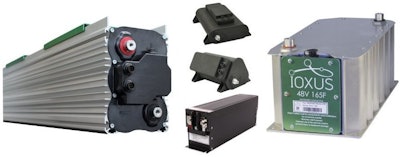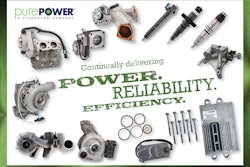
Every component on a heavy-duty truck serves a purpose. The ultracapacitor (or ultracap) is one such component. It can help the operation of a truck, but also can be unnecessary in certain circumstances.
Last month Trucks, Parts, Service reported on getting the most from batteries. The discussion wouldn’t be complete without talking about ultracapacitors, too.
The capacitor acts as like an electronic shock absorber, handling the high current demands, and enables the remaining batteries to provide low current, steady energy requirements,” says Chad Hall, senior vice president, sales and operations, Ioxus. The less you cycle the battery, and the higher the voltage stays in the battery, the longer the battery lifespan, Hall adds.
“All trucks can benefit from an ultracapacitor system by improving the starting reliability. From cold temperatures; improved system voltage conditions during cranking, longer battery, starter and ancillary electronics life; the capacitor has a very high charge acceptance, even at cold temperatures; and charges extremely fast to always be available for the next starting event,” Hall says.
John Miller, senior director, product engineering, Stryten Manufacturing, says advantages and disadvantages exist when using an ultracapacitor for Class 8 applications. “First, it’s important to understand that ultracaps are a great source of instantaneous power as needed for engine starting. However, they do not store any significant energy that is required to support lower amperage draw or longer run time loads,” Miller says.
The case for ultracaps
Ultracapacitors, which have been around for a long time, offer an electrical storage of energy that allows immediate access to high amounts of energy, says Jeremy Cordray, director of technical sales, transportation markets, EnerSys.
“The capacitor charges almost instantly and stays ready the next time the truck is started,” Hall says. “The capacitor then provides the power to crank the engine and the energy/voltage to support ancillary electronics. By improving the voltage condition, and supplying the right power to the starter, the starter life extends, and relays, ECUs, ECMs and other electronics have their lives extended.”
Miller says additional advantages to an ultracapacitor include: The ultracap will ensure an engine starts even when the main bank of batteries are not able to, which can save the costs of a roadside jumpstart as well as mitigate any late delivery penalties. “This is particularly helpful when sleeper cab loads are draining the batteries to low states of charge or when the batteries are near end of life,” he says.
“The life cycle of an ultracap is generally longer than that of a typical battery, meaning that a single ultracap does not always need to be replaced when a new set of batteries is installed,” adds Miller.
Reasons to rethink ultracapacitors
Using an ultracapacitor has its drawbacks if not used correctly or if it’s used in a truck that can’t really take advantage of an ultracapacitor.
Interstate Batteries says the only time ultracapacitors are useful is if it’s a day cab driver, “meaning there’s no sleeper units because a capacitor is an energized battery enabling you to output a high amount of power in a very short duration and then it has to be recharged again,” Barron says.
He adds sometimes customers will want to remove the fourth battery and use an ultracapacitor in that battery’s place. “You still have to remember there’s still excessive drain with the engine off so if it’s a day cab driver is understandable and that’s fine,” he says.
Another downside is ultracapacitors tend to be four to five times the cost a battery, Miller says, meaning the cost of one ultracap is roughly the equivalent of four batteries.
“Unless the truck is designed for a specific space to house the ultracap, one of the batteries in the battery bank needs to be removed to make it fit. This means the total energy of the battery pack is now reduced by 25 to 33 percent depending on the battery bank size. This will limit battery capacity energy available to service cab loads,” Miller says.
Education through demonstration
There appears to be misconceptions and misinformation as to how and when to use an ultracapacitor. For this reason, suppliers need to educate dealers who, in turn, can pass that knowledge onto their customers.
“The first thing to show a dealer when explaining how ultracapacitors work is to install one in a truck. Remove one to three batteries, based on the application and engine size, then start the truck. Noticeable is the 40 to 70 percent faster start time when using the ultracapacitor,” Hall says.
“And then we show field testing data that shows how the capacitor works at all temperature ranges, making sure cold engines can start,” he says. “We have data that shows how the voltage on the remaining batteries is improved over time, how the start is faster, how the crank is smoother and we have a return on investment sheet that shows the amount of time it takes to pay back the cost of the capacitor.”











